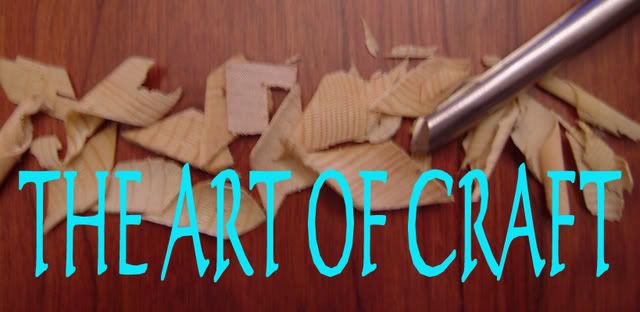If you have read my articles on this site on Selling Wholesale, some of what you will read in this article will not be new to you (some of it will). But many who have no interest in selling wholesale, have many questions about how to price their crafts or artwork for sale.
Pricing is a difficult issue for many artists and craftspeople. They tend to devalue their work and place lower than market prices on their work. There is a whole psychology of this that we will not go into detail here, but it is important to understand the basics of pricing.
To price an item you need to take the costs of all materials, supplies, and expenses that make up an item and then add that to an hourly rate that you as the artist must determine that your labor and talent are worth. Start with the minimum wage and work up from there. You should certainly be paid the minimum wage. Of course, you should be paid more than the minimum wage. It is up to you to decide what you are worth per hour. Multiply the number or fraction of hours that it took to create your item. Add that item to your costs. The result is actually what should be your wholesale price and not your retail price.
You are not finished yet. To sell that item on your own you may have other expenses. If you are on an internet site that charges fees you now need to add those fees. If you sell at a craft show the table space will cost you money. You need to proportion that into your prices. If you take credit cards or use Paypal you must pay fees. Those fees need to be added into the price. Ideally when you are done you are at or near doubling that wholesale price that you came up with a few moments ago. (See why retailers double your wholesale price - they have these expenses too, only greater if they have a brick and mortar store.) Many craftspeople will feel that their item will not sell at double that initial price and feel uncomfortable about offering the doubled price when they try to sell the item on the internet or at a craft show. Eager to make sales they often offer their wholesale price to the public. This is a problem if you ever decide to sell wholesale. Retail shops do not want to compete with you and want to see that the price that they are paying wholesale is significantly less than your usual prices.
Put all of this together and we get a basic formula that anyone can follow to determine a price for a handmade item:
Cost of materials +
Cost of supplies +
Cost of Expenses (utilities consumed in creation) +
Self-determined Hourly Rate +
Fees to Sell (listing fees, show fees, credit card fees) =
PRICE
There is also a factor that many retailers consider and add or subtract from the price. It is the concept of "what will the market bear". This includes competition and demand. You may come up with a price of $5.00. Other similar items sell for $3.00. You may have to find a way to reduce your costs to be able to make your item for $3 to be able to sell. If you can't find a way to do this you may need to decide that this is not an item that will sell. If you can test market it for a time at the higher price you will be able to know for sure. The other thing to consider is that some things are just not worth the higher price that you want. There is just so much that people will pay for some things. On the opposite end of this, you may find that you can price an item at $20 but other similar items sell for $50.00. You could try to sell your item for $30 less with the idea that you will sell more because you have a better price. But - some buyers will look at your less expensive item and start questioning why is it so much less. They may conclude that it is "not as good" as the similar item selling for more. In this instance you may want to raise your price to keep it in line with similar items.
All of this is not as hard as it may read. Follow the formula and you will get solid prices. Compare your prices to similar items on the sites you are selling on or at the craft shows that you participate in and make adjustments if necessary.
Subscribe to:
Post Comments (Atom)













8 comments:
I have enjoyed and learnt from your article. My sister knits and you are right, sometimes it is a bit hard to know how much to charge. Thanks a lot for all the advice. We will recommend your blog in our blog. Monica
great post!
Good post. Clear and concise.
The other consideration when pricing is galleries, who usually want a very large percentage. If you add this percentage on to your normal price then your gallery prices can seem expensive. Conversely if you don't you risk taking a big hit to your profit.
You have to ask yourself whether the exposure is worth the drop in income. As gallery shows are usually short time-frame, it might be worth taking that hit. If the show works out well you can more than re-gain it later.
Bob
My gallery takes 40%. I calculate this on to my base price and that is what the gallery charges. This takes the place of the selling fees that I would be adding on to the base when selling directly.
Sometimes the price you can charge is way above the materials cost. Earrings and bead bracelets come to mind, especially if you are able to get your materials at wholesale.
I go to a mall department store or a boutique in a nice part of town and price my things about the same. Sometimes this price is significantly higher than even my highest formula markeup. If these places are getting those prices, I should be able to as well. The customers are used to seeing those prices and won't think anything of them. I can always drop the price, but people will be suspicious if the price is too low. What's wrong with this? they will ask themselves, and stay away. A higher price on a good quality item places more intrinsic value on it in the customer's mind.
Otherwise I use this formula:
wholesale (sell to shops) 3x cost
direct (shows) 4.5x cost
retail (MY retail outlet) 6x cost
when I sell online I usually try for the retail price. When I do shows it depends on the venue. If I'm in a tent outside, I'm not going to get my boutique price. But if I'm able to sell at a trunk show and have an elegant display, you can bet those prices go up as far as I think I can push them. Much of the value is in how the product is displayed.
Everything I make, I like, so if it starts sitting around I'll wear it. I have sold earrings, bracelets, and necklaces right off my person more than once, so I make sure to always know the price of the product I'm wearing.
Brilliant post, it has been extremely useful - I've gain some terrific insights. From the comments as well....
Quick question if I may, what is the difference between materials and supplies in formula?
Thx
Materials and supplies to some are the same. It depends on how one looks at what one works with, for example, a board of wood might be materials while the hinges and hardware would be supplies. As long as all of this is accounted for in the price, it is just a case of semantics.
Hey Robert!
Thanks for confirming that and so promptly, I appreciate it. Figured as must just need to be sure - it's all new to me... Your brilliant blog posts on pricing and wholesaling have been most helpful. I've now subscribed to your blog feeds and following you on twitter :-) See ya around... Cheers!
Post a Comment